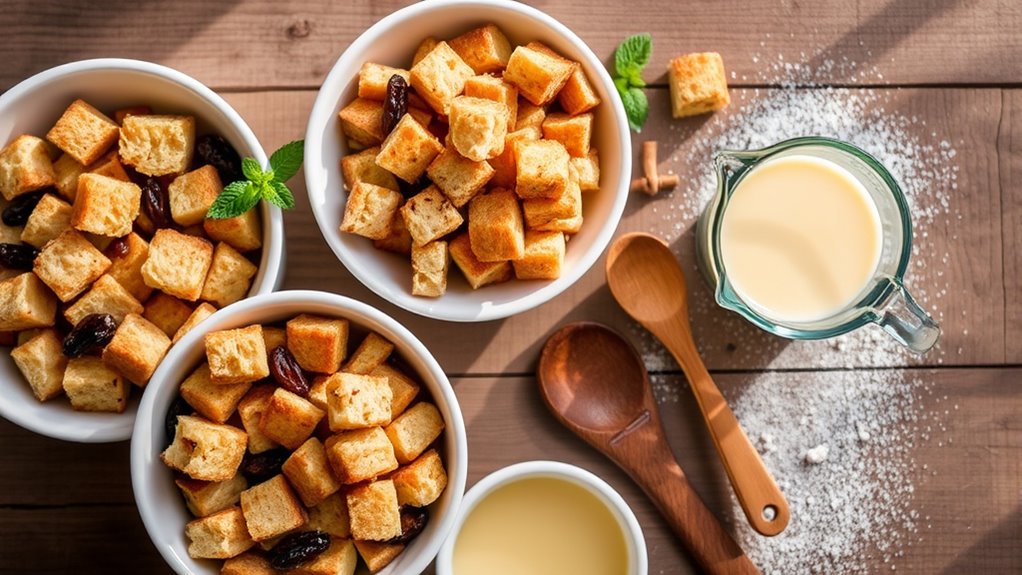You’ll start by cubing day-old brioche or French bread and soaking it in a rich custard of eggs, milk, sugar, and vanilla. After soaking, transfer it to a buttered dish and bake at 350°F for about 50 minutes until the top’s golden and the center gently jiggles. Serve warm with bourbon caramel sauce and whipped cream. With simple steps and thoughtful touches, you’re just moments away from a classic Southern delight—ready to discover more secrets for perfecting this iconic dessert?
Ingredients and Quantity

Before you plunge into making this delicious bread pudding, you’ll want to gather a few simple ingredients that come together perfectly to create its rich, comforting flavor. Choosing the right bread types is key—whether you prefer classic French bread or a sweeter brioche, each lends a unique texture and taste. This recipe embraces dessert variations, allowing you to customize with nuts, raisins, or chocolate chips. Here’s a clear guide to the essential ingredients and their quantities:
| Ingredient | Quantity |
|---|---|
| Bread (cubed) | 6 cups |
| Eggs | 4 large |
| Milk | 2 cups |
| Sugar | 1 cup |
With these basics, you’re set to explore freedom in flavor and style.
Preparations
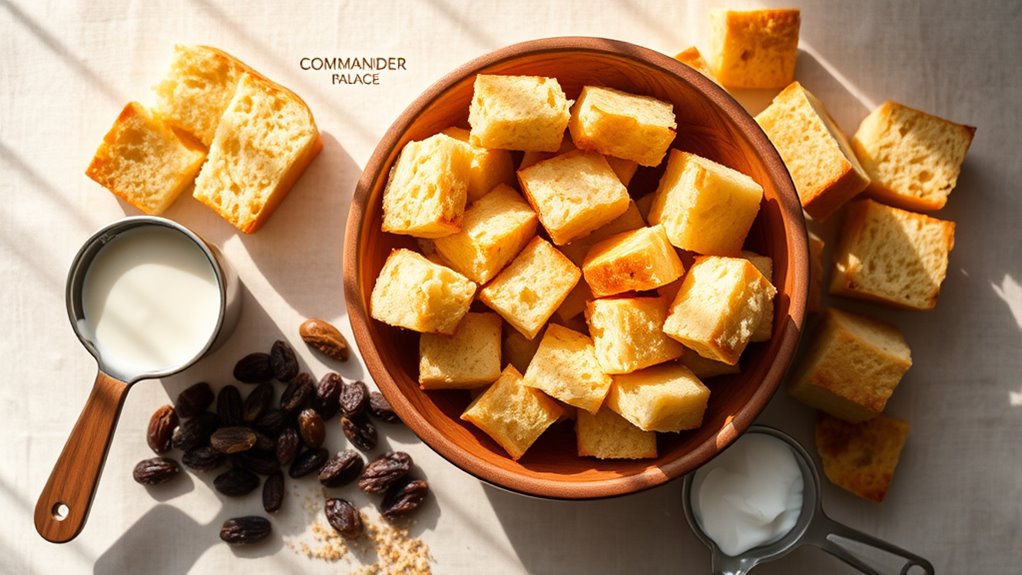
Getting your ingredients prepped right is the first vital step to making a perfect bread pudding. Begin by focusing on your bread selection; choose day-old brioche or French bread for that ideal texture and flavor. Once you have your bread, cut it into uniform cubes to guarantee even soaking. The soaking technique is essential—immerse the bread gently in a rich custard mixture, allowing it to absorb moisture without becoming mushy.
Start with day-old brioche or French bread, cut into cubes, and soak gently in rich custard for perfect texture.
Picture this:
- Golden cubes of bread soaking luxuriously in creamy custard
- A bowl filled with aromatic vanilla and spices mingling with eggs
- Butter melting softly in your baking dish, ready to cradle the pudding
How to Cook
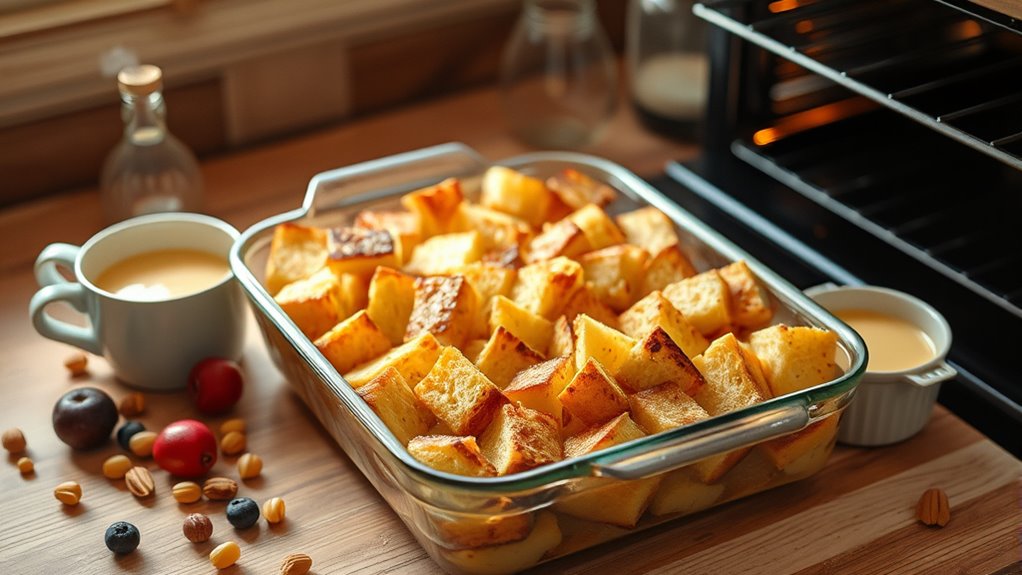
- Soak the bread cubes in the custard until they have absorbed it well.
- Transfer the custard-soaked bread cubes into a buttered baking dish, ensuring they are spread out comfortably without overcrowding for even cooking.
- Preheat the oven to 350°F (175°C).
- Place the baking dish on the center rack of the oven.
- Optional: Use a water bath to achieve a creamier texture by gently regulating the heat.
- Bake for 45-55 minutes until the top is golden and the center is set but still slightly jiggly.
- Experiment with adding fruits or nuts to the mixture before baking for dessert variations.
- Mastering these techniques will help you create a rich, soulful, and unique bread pudding.
How to Serve
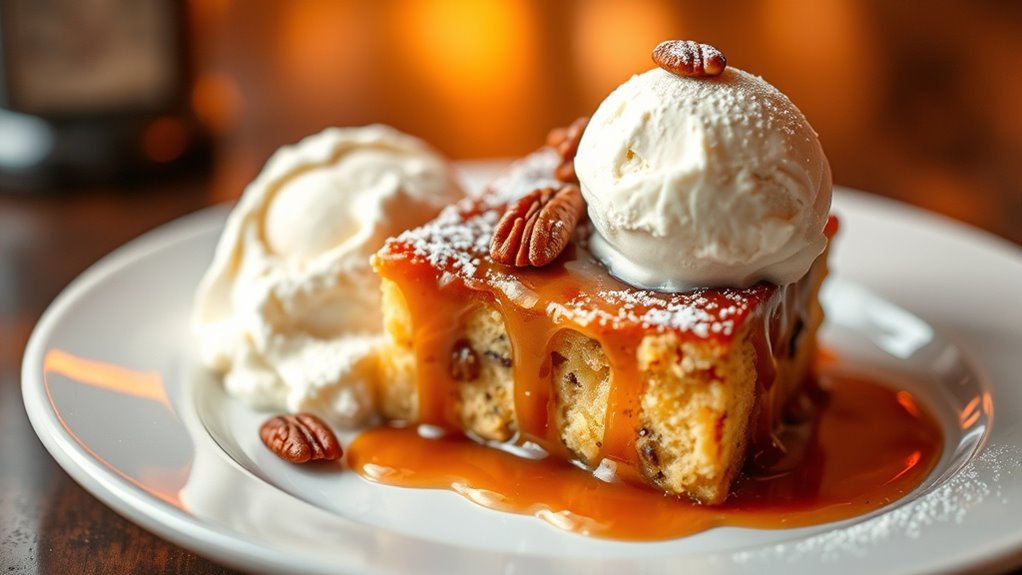
Presentation plays a key role in elevating your bread pudding from a simple dessert to a memorable experience. When thinking about serving suggestions, consider how each element can complement the rich, custardy texture and warm spices. Here are some presentation ideas to inspire you:
Presentation transforms bread pudding into a memorable dessert, enhancing its rich texture and warm, comforting spices.
- Serve warm slices drizzled with a bourbon caramel sauce, letting the glossy drizzle catch the light.
- Add a dollop of freshly whipped cream or a scoop of vanilla bean ice cream for a creamy contrast.
- Garnish with toasted pecans or a sprinkle of powdered sugar to add texture and visual appeal.
Tips
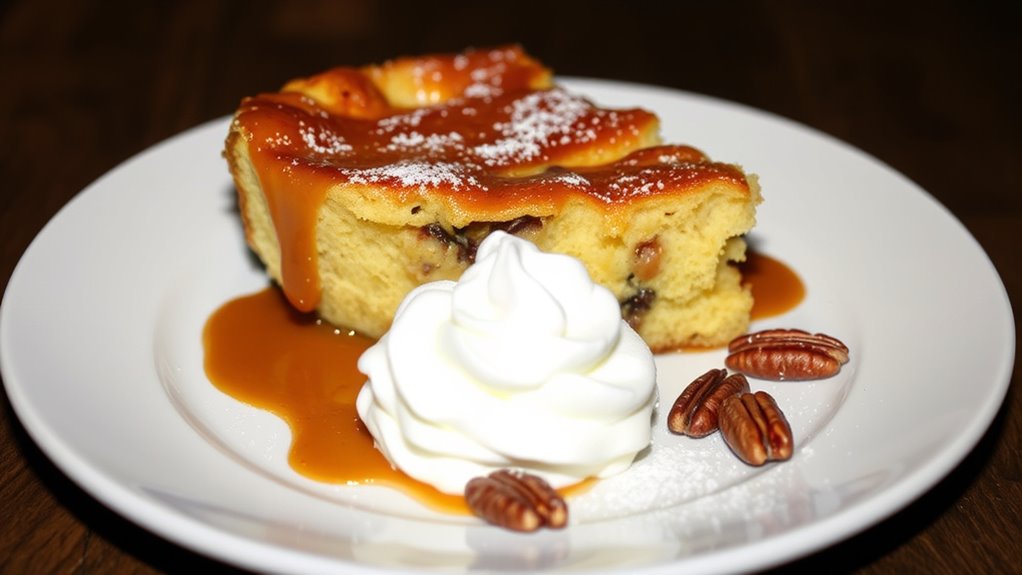
Although bread pudding is forgiving by nature, there are a few key tips that can help you achieve the perfect balance of custardy interior and golden, slightly crisp top. First, soak your bread thoroughly but avoid oversaturating it—this guarantees a tender texture without sogginess. Mastering baking techniques like using a water bath can gently cook the pudding evenly, preventing cracks. Don’t shy away from experimenting with flavor variations; adding citrus zest, spices, or different extracts can elevate your pudding uniquely. Also, letting your bread sit out to slightly stale helps it absorb the custard better. Finally, keep an eye on the oven—the pudding should jiggle slightly when done. These tips give you the freedom to craft an irresistible bread pudding every time.
Food Value and Benefit
Bread pudding, beyond being a delightful dessert, offers valuable nutritional benefits that contribute to a balanced diet. This prepared dish combines key ingredients that provide essential vitamins and minerals along with macronutrients. Enjoying bread pudding can support your overall health in the following ways:
- Provides high-quality protein from eggs, which aids in muscle repair and sustained energy.
- Supplies calcium and vitamin D from milk, essential for maintaining strong bones and healthy teeth.
- Contains vitamin A from eggs and milk, supporting vision and immune function.
- Offers B vitamins (such as B2 and B12) from eggs and milk, important for energy metabolism and red blood cell formation.
- Delivers dietary fiber from whole-grain bread, which promotes healthy digestion and helps keep you feeling full longer.
- Includes important minerals like phosphorus and potassium, contributing to cellular function and heart health.
This combination makes bread pudding a nourishing treat that balances indulgence with nutritional value.
